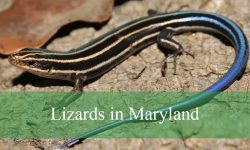In the world and North America, there are thousands of small green bug species. Some fly, while others crawl; grasshoppers, for instance, may even jump. Their green hue serves as camouflage, blending them with the leaves they feed on or inhabit. Bugs often start as differently-colored nymphs before maturing into predominantly green adults, with some species featuring uniform coloring and others a mix of hues.
Different Types of Small Green Bugs
Potato Aphid
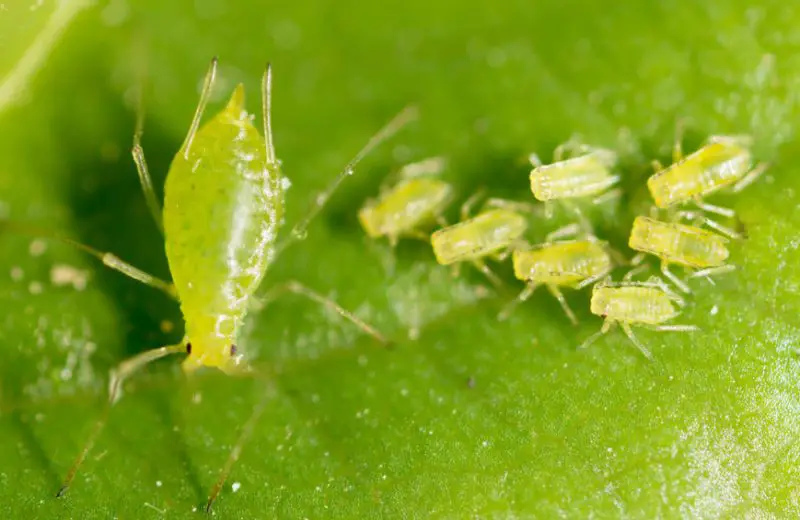
The Potato Aphid (Macrosiphum euphorbiae) poses a significant threat to crops, boasting a green body and large, transparent wings. Their presence signifies potential damage, especially to potatoes and fruit trees like peaches. Found on crops and invading greenhouses, they feed on plant tissue and sap, causing considerable harm.
California Timema
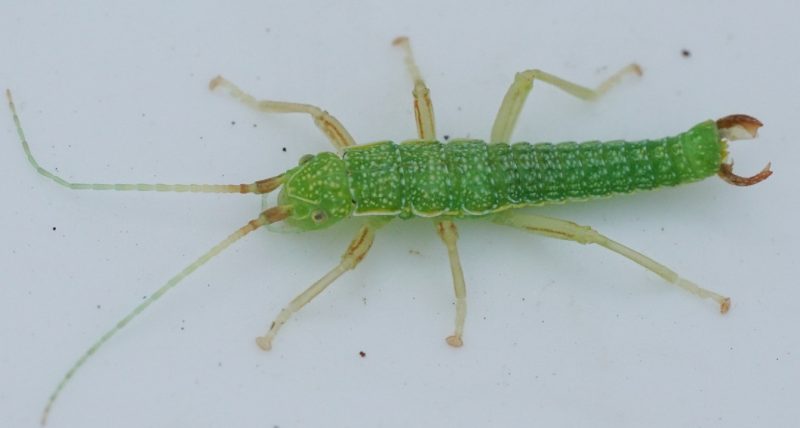
The California Timema (Timema californicum) is distinguished by its unique tubular body resembling a stick. Its dark green hue extends to lighter green legs and bright green to white antennae. Contrasting brown cerci and small yellow dorsal dots, along with long lateral yellow stripes, further identify this species.
Dogbane Leaf Beetle
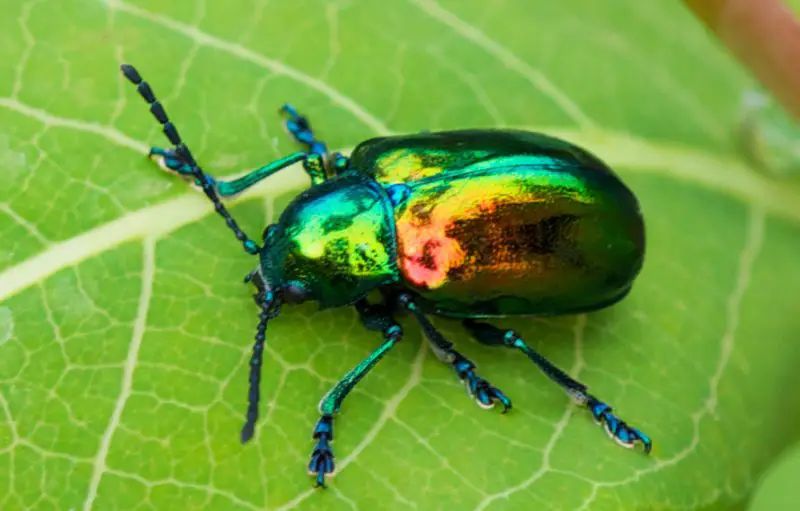
The Dogbane Leaf Beetle (Chrysochus auratus) is specialized to feed exclusively on dogbane, a toxic plant harmful to animals and humans. Resistant to its toxins, the beetle showcases a metallic green elytra, with a distinctive brown section outlined in gold. Its legs are half green and half black, while the antennae are entirely black. Typically measuring 8-9mm, it lays eggs on the underside of dogbane leaves as part of its lifecycle.
Common Green Bottle Fly
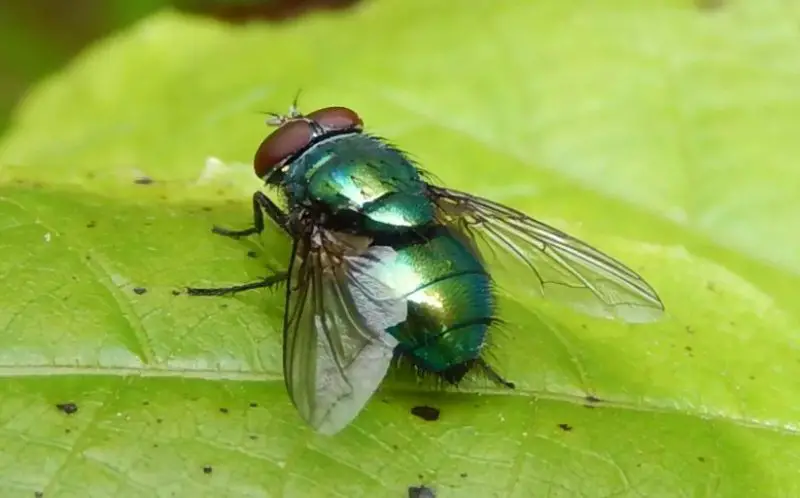
The Common Green Bottle Fly (Lucilia sericata) thrives in both moist and arid regions of the US, boasting a metallic green body. Abundant in spring and summer, they mate prolifically. Females lay eggs in carrion and on living livestock, posing disease risks. Certain sheep species are especially susceptible, with direct egg laying on skin leading to potential infections like myiasis.
Green Stink Bug
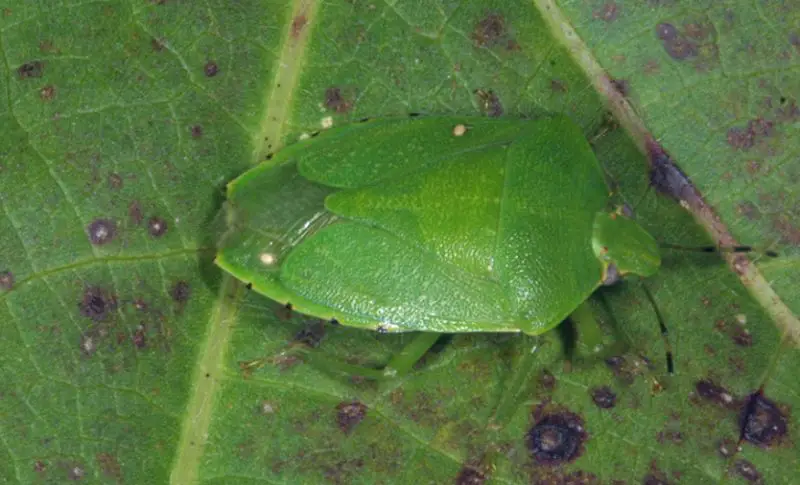
The Green Stink Bug (Chinavia hilaris) earns its name from its all-green hue, a common sight in gardens worldwide, especially in summer. Known for invading crops like soy, eggplant, and beans, they also target fruits such as peaches and pears, preferring legumes like corn. Their feeding habits inject enzymes into plants, leading to reduced fruit yield or even plant death. Nymphs, smaller and black in color, resemble the adult but lack its green hue.
Pale Green Assassin Bug
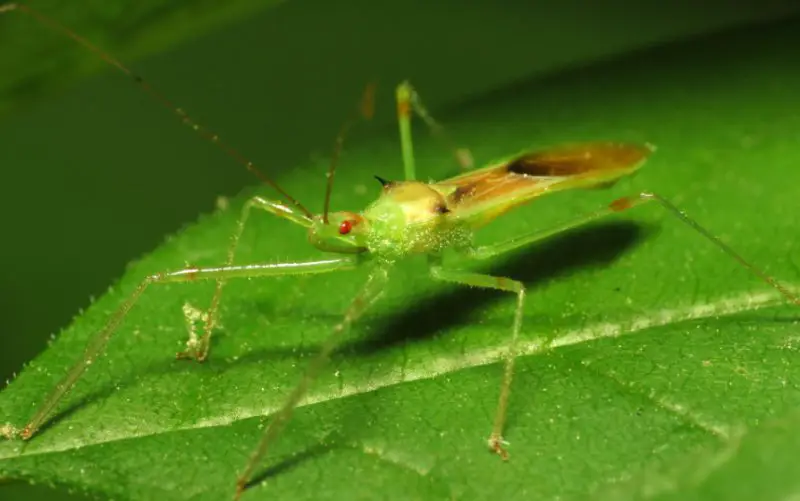
Pale Green Assassin Bugs (Zelus luridus) remain green throughout their life stages, aiding in camouflage. Nymphs and adults sport this hue, with adults featuring yellow and brown wing markings. Masters of ambush, they often lie in wait for prey, but can also actively hunt. Their stillness on leaves renders them invisible to unsuspecting insects, making them efficient predators.
Broken-Backed Bug
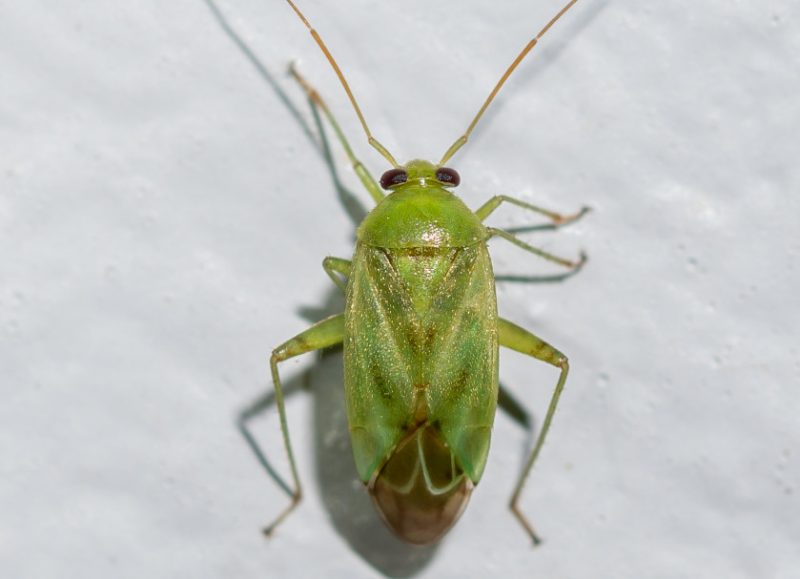
The Broken-Backed Bug (Taylorilygus apicalis) is distinguished by its pale green, almost transparent hue. While it typically appears green, some specimens may display a rare brown morph. Feeding primarily on asters, they also target willow and other plants in riparian areas when aster is scarce.
Rice Leaf Bug
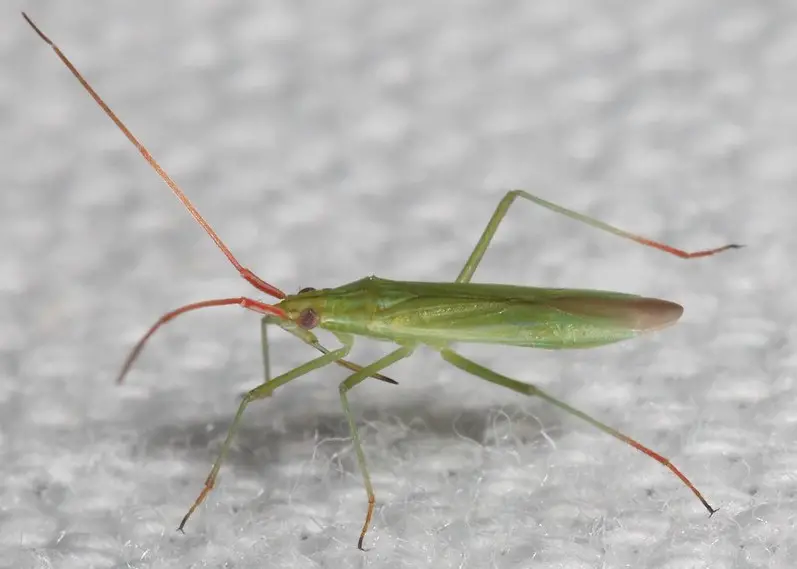
The Rice Leaf Bug (Trigonotylus caelestialium) is a common pest of forage crops, with a slender green body, light brown legs, and antennae. Originally from Asia, it has spread to North America, particularly infesting rice fields. Initially not a primary food source, rice grains have become a staple, prompting management efforts focused on prevention to mitigate damage to crops.
Northern Flatid Planthopper
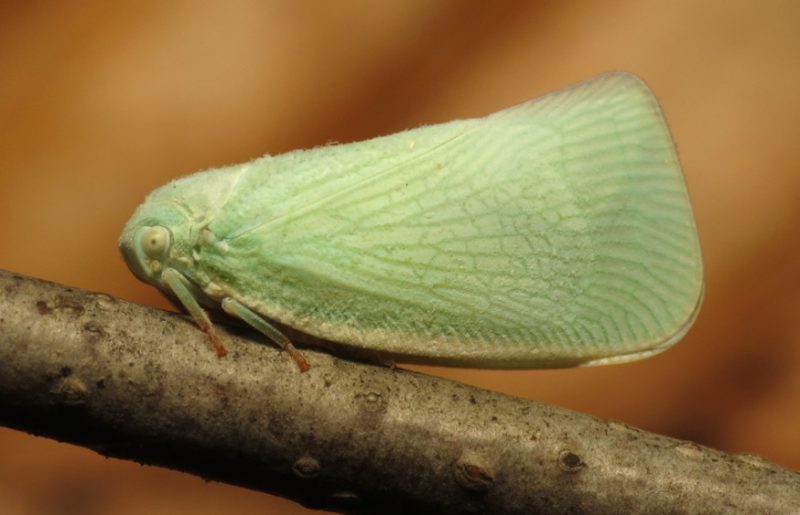
The male Northern Flatid Planthopper (Flatormenis proxima) stands out with its bright green coloration, featuring multiple nuances. Its base color is bright green, while the veins darken to a deeper green. With short, thin legs and a body matching its vibrant hue, it blends seamlessly into foliage, aided by its unique leaf-like wing shape.
Figeater Beetle
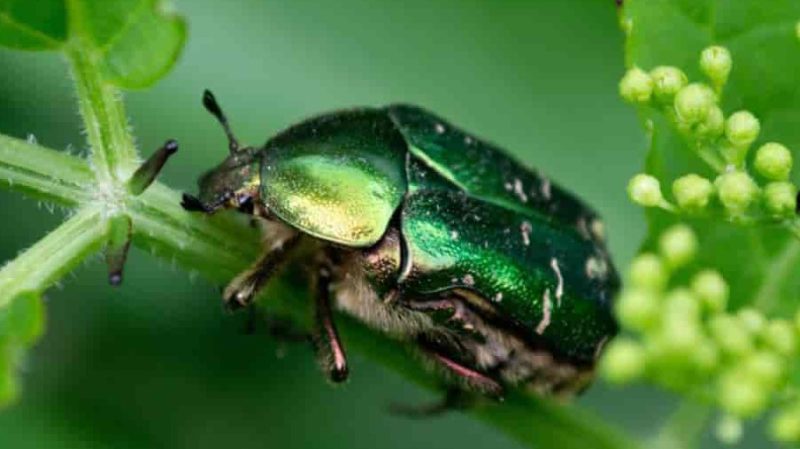
The Figeater Beetle (Cotinis mutabilis), one of Southern North America’s largest beetles, measures up to 1.2 inches and frequents gardens and homes. With a penchant for organic matter and fruit, it’s commonly spotted on apple and peach trees. Recognizable by its predominantly green hue, adorned with yellow to golden lateral stripes, it resembles Green June Beetles. Their green coloration may vary based on diet, such as cacti found in moist areas. Unlike other green bugs, Figeater Beetles prefer moist environments, often found in the Southwest’s damp regions.
Green Immigrant Leaf Weevil
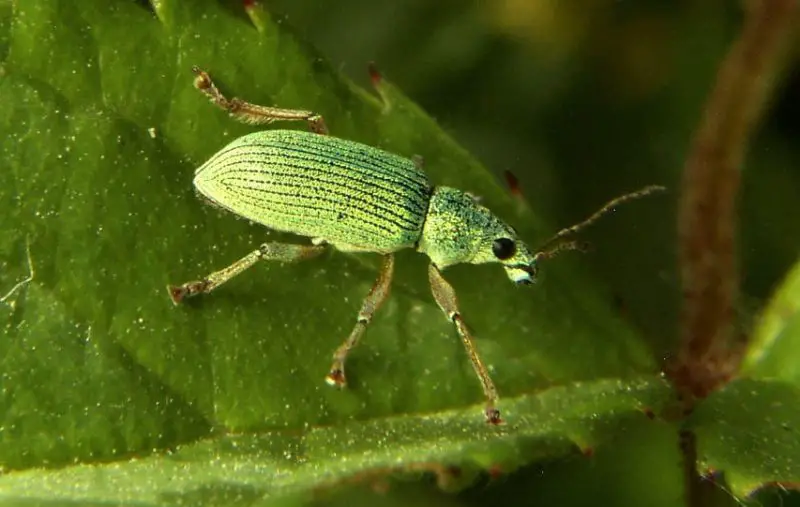
The Green Immigrant Leaf Weevil (Polydrusus formosus) is a predominantly green plant-eating insect. Its bright green elytra with an emerald undertone feature striations and a black central dorsal section. Golden yellow nuances adorn its body, while its legs and antennae are mostly green. Despite its small size, reaching only 0.2 inches, it poses a threat to garden fruits like apples, strawberries, and berries.
Green Cone-Headed Planthopper
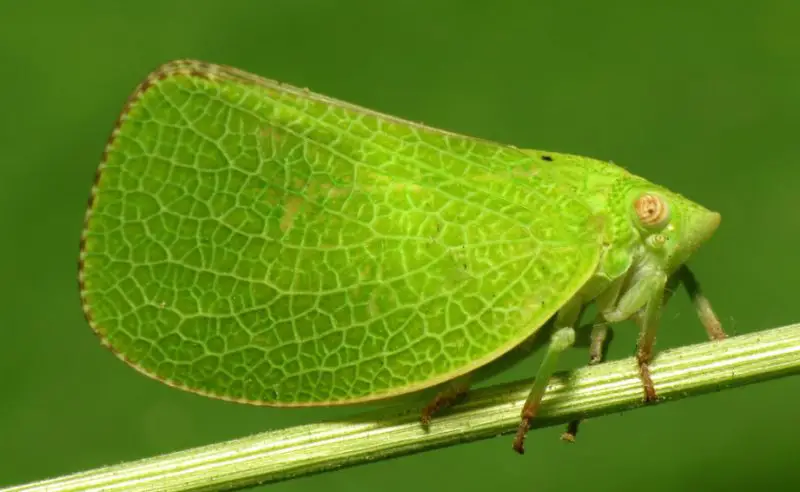
The Green Cone-Headed Planthopper (Acanalonia conica) boasts a leaf-mimicking appearance with dark green wings, body, and head. Lighter green veins on its tent-like wings enhance its camouflage. Capable of secreting a wax-like residue, especially in nymphs, it deters predators. Preferring hopping to flying, it can cover distances of over 10 inches. Primarily found in the Southeastern United States, its feeding on leaves rarely harms host plants, but excessive honeydew secretion can promote mold growth, potentially damaging the plant.
Versute Sharpshooter
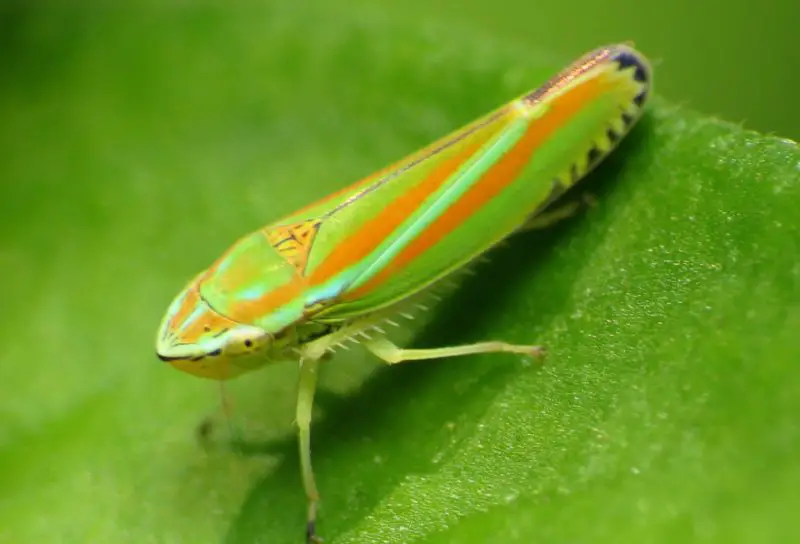
The Versute Sharpshooter (Graphocephala versuta) sports a green base color with blue, brown, or tan stripes on its wings, accentuated by black markings. Rapidly reproducing, they rely on their green hue and diminutive size for leaf-feeding camouflage, often hiding beneath leaves. Common in Costa Rica and partially in the United States, they form sizable populations.
Potato Leafhopper
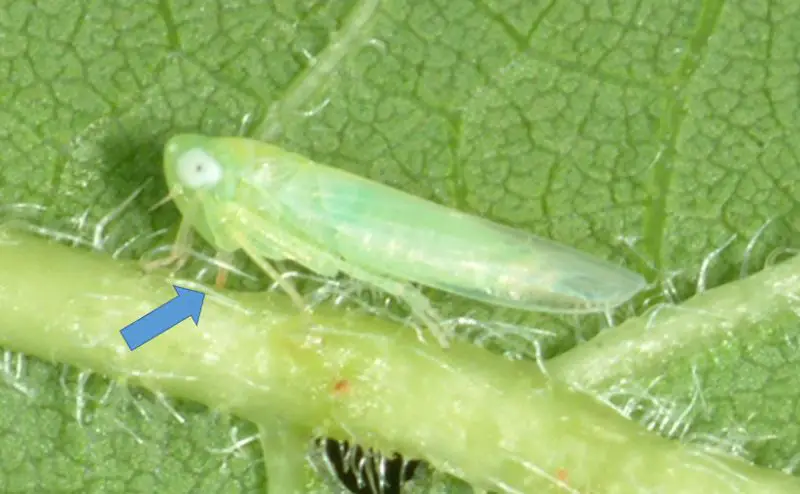
The Potato Leafhopper (Empoasca fabae) is a tiny, green pest measuring under 3mm that infests numerous plants and legumes, notably potatoes and clover. Its green body is marked by wing spots and faint yellow stripes behind the head. Capable of long migrations, they pose a challenge to farmers, often flying unnoticed at night.
Torpedo Bug
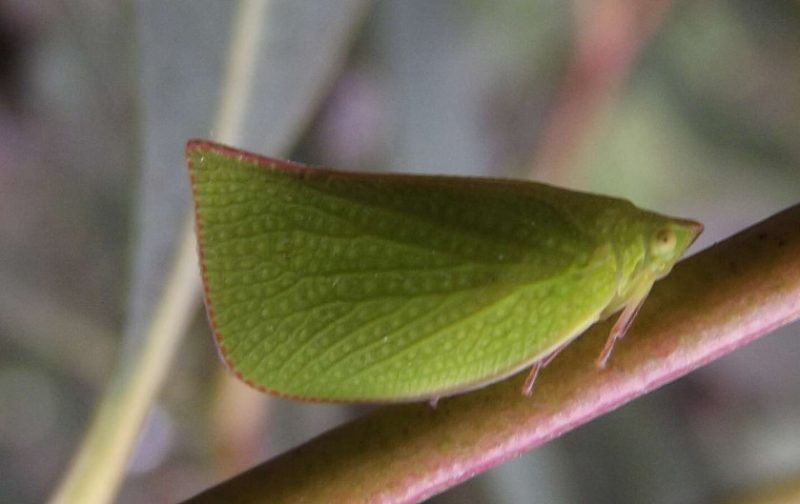
Torpedo Bugs (Siphanta acuta), native to Australia, are now spreading across continents, including North America, and are distinguished by their uniform green coloring at all life stages. While nymphs exhibit a faint green hue, adults darken slightly but retain green covering the head, body, and tent-shaped wings. Typically large leafhoppers, reaching up to 10mm, feed on leaves without causing significant damage, often protected by a waxy substance, particularly in their smaller nymph stages.
Green Lynx Spider

The Green Lynx Spider (Peucetia viridans) is among the largest green spiders, featuring a dark green body and bright green to white legs. Harmless to humans, it utilizes its green hue for prey capture, often found on crops where it acts as a biological control agent by feeding on pests like the Cotton Leafworm Moth. However, it may also consume beneficial insects.
Red-Spotted Orbweaver
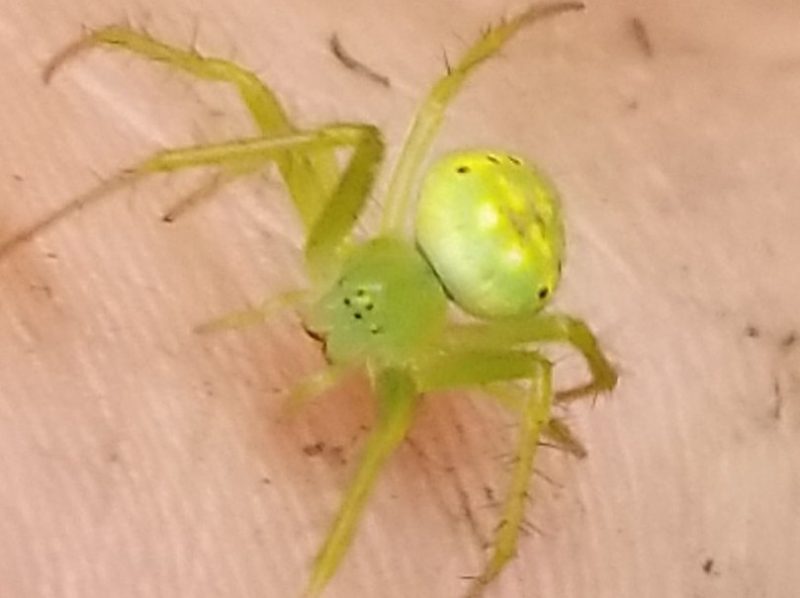
The Red-Spotted Orbweaver (Araneus cingulatus), common in North American woodlands, is a green spider rarely seen due to its arboreal habitat. Its predominantly green body blends into foliage, often overlooked by passing insects. Sporting uniform green legs and a bulbous body, it features distinctive yellow dorsal coloring adorned with tiny red dots.
Praying Mantis
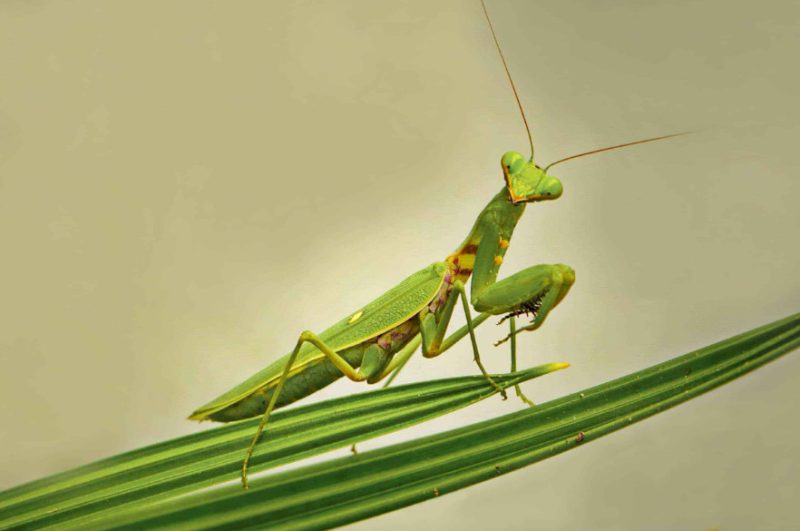
Praying Mantises, with over 2,000 species worldwide, including 21 in North America, often exhibit green or brown hues for camouflage. Utilizing their strong raptorial legs, they patiently await prey, primarily insects and spiders, before striking. The Chinese Mantis, reaching 5 inches in length, is the largest known species, found in states like Missouri, relying on its green coloration for predation.
Green Mantidflies
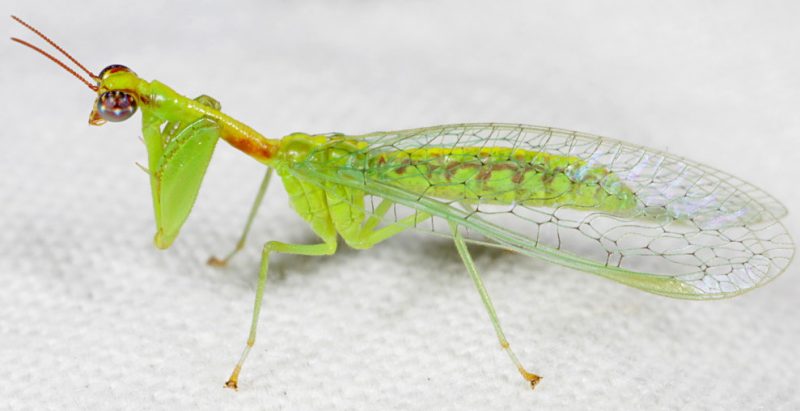
The Green Mantidflies (Zeugomantispa minuta) are flying insects resembling distant relatives of the Praying Mantis. Mostly green with long, transparent wings, they feature purple to brown marks beneath. Found in Central and North America, their forewings and hindwings display contrasting black veins.
Grasshoppers

Green is indeed a prevalent hue among grasshoppers, especially within the True Crickets or Ensifera group. These insects typically sport long, vibrant green bodies and wings, which play a crucial role in generating their distinctive noises. Renowned for their remarkable jumping prowess, grasshoppers employ their powerful hind legs to propel themselves significant distances, navigating their environment with agility and speed.
Katydids
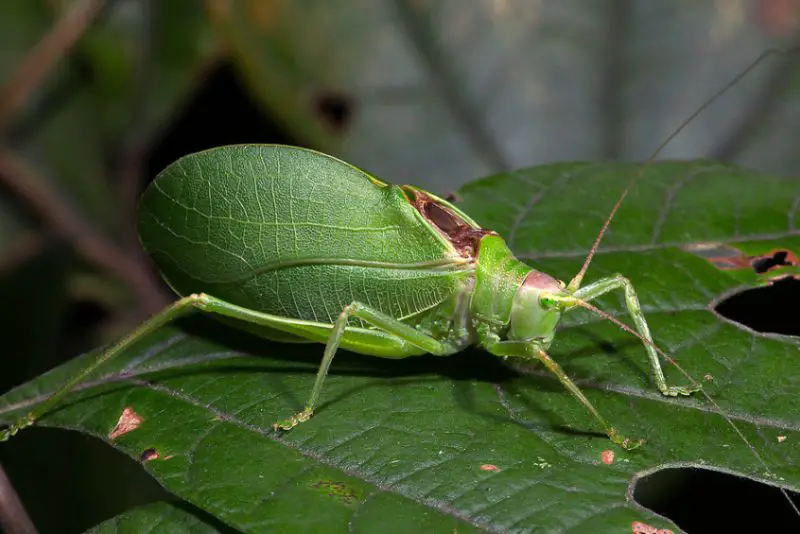
Katydids, ubiquitous worldwide, encompass thousands of species, some featuring all-green coloring. Their predominantly green hue serves as camouflage, often mimicking leaves to evade detection. False Leaf Katydids, a subspecies, mimic both the color and shape of leaves. Additionally, they produce bird-like chirps, adding to their camouflage.
Green Lacewings
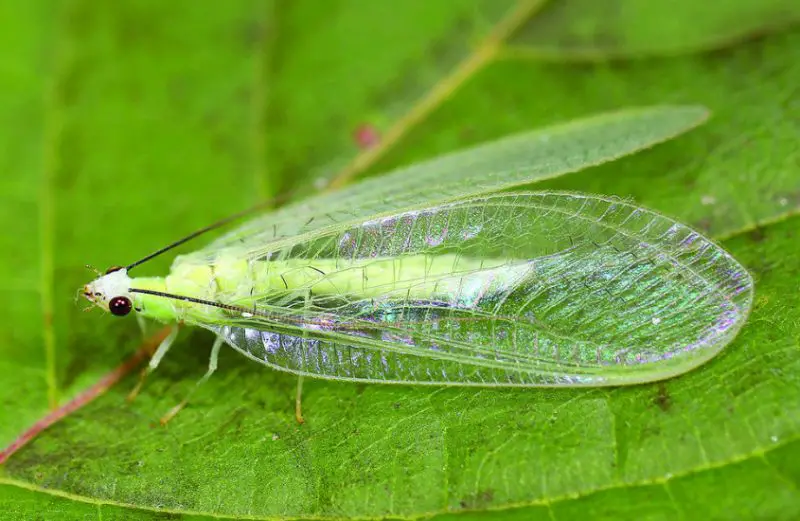
Green Lacewings, belonging to the family Chrysopidae, are prevalent green bugs in North America, boasting a wingspan of up to 60mm. Though smaller than their tropical counterparts, they still impress with their size. Sporting a green base body color, ranging from pure green to yellow, they feature large golden or brown eyes and transparent, iridescent wings with green or green-and-black veins.
Banana Cockroaches
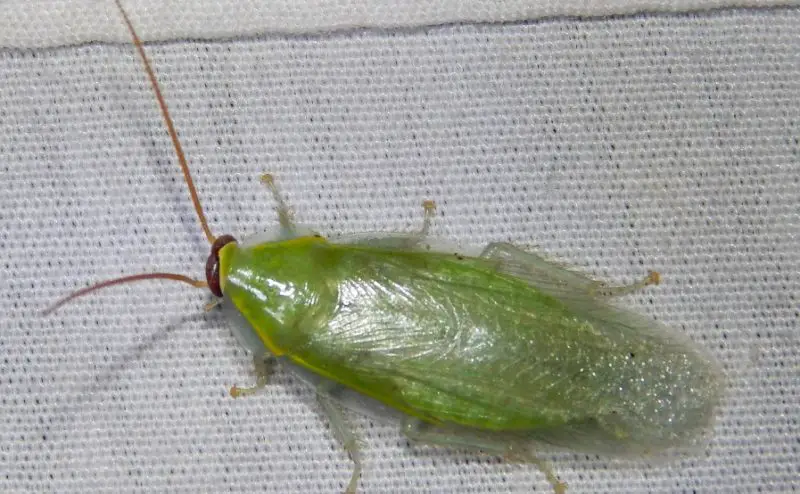
Banana Cockroaches (Panchlora nivea) are frequently found in Southern US states, though their tropical origins extend northward to South Carolina. Unlike typical roaches, they boast a distinctive lime or bright green hue, a trait that develops as they mature from their initial dark brown appearance. Rarely pests indoors, they’re more commonly spotted outdoors, particularly near fresh or decaying fruit and vegetation.
Tree Crickets
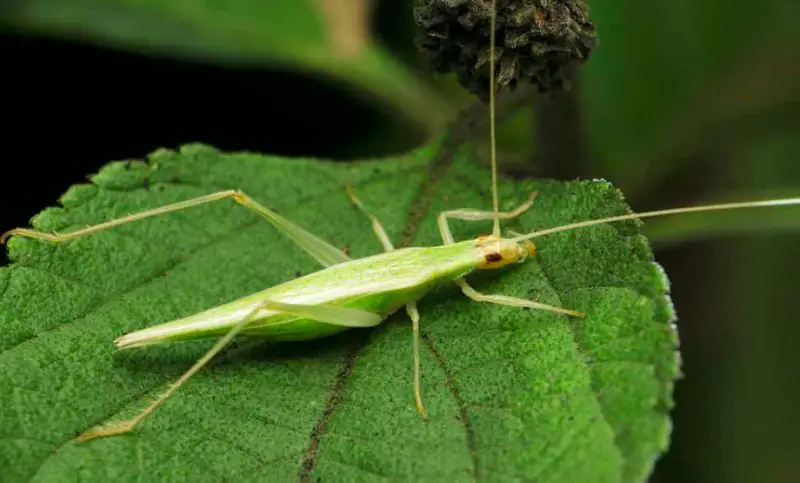
Tree Crickets, belonging to the subfamily Oecanthinae, are characterized by their predominant green coloring, which extends to their body, wings, legs, and antennae. Nocturnal by nature, they blend seamlessly with foliage while resting on plant leaves. Their eyes may exhibit hints of green or yellow. While most prevalent in North American habitats, certain subspecies may appear brown. Notably, the Snowy Tree Cricket stands out with its vibrant green hue, reaching around 0.6 inches in size.
Pure Green Sweat Bee
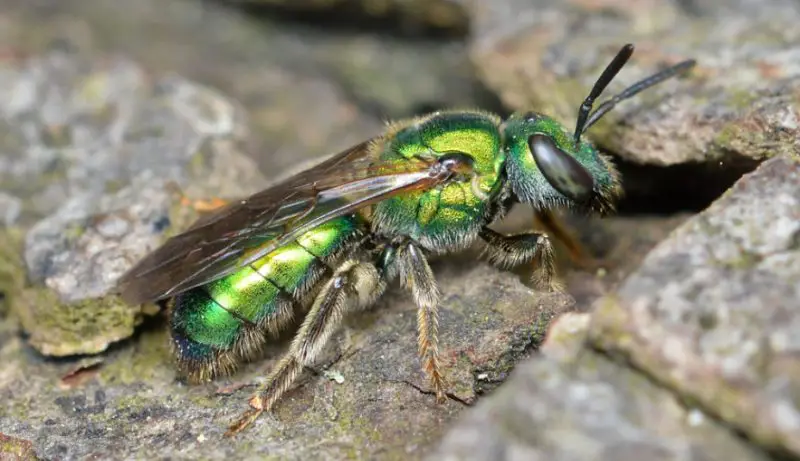
The Pure Green Sweat Bee (Augochlora pura) is distinguished by its predominantly green coloring, found in the eastern parts of North America. Active only in summer, they exhibit a green body with dark legs adorned with white hairs. Their large black eyes and smoky, transparent wings add to their distinct appearance. Come fall, females retreat into dead wood or under tree bark, while males perish, only to reappear in spring and early summer.
Brown-Winged Striped Sweat Bee

The Brown-Winged Striped Sweat Bee (Agapostemon splendens) shares a predominantly green hue with the Pure Green Sweat Bee but boasts a wider distribution across the US, spanning from Montana to Texas. Sporting white or yellow abdominal stripes against a green backdrop, and black legs and antennae, it exhibits varied eye colors, ranging from yellow to silver. Its wings, smoky brown and slightly translucent, lend the bee its distinctive name.
Texas Striped Sweat Bee

Texas Striped Sweat Bees (Agapostemon texanus) hail from the southern US but have spread across North and Central America. Both males and females feature a predominantly green thorax, while males sport yellow and black striped abdomens. Growing up to 11mm, females are slightly larger. They nest underground, with females constructing extensive nests comprising over 10 tunnels or chambers. Active in summer, they exhibit a strategic pollen-collection approach, visiting numerous flowers per hour.
Metallic Bluish-Green Cuckoo Wasp
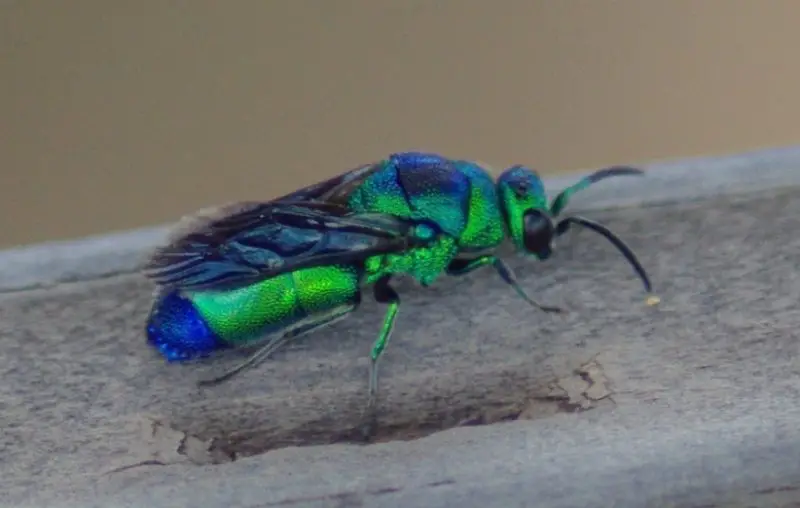
The Metallic Bluish-Green Cuckoo Wasp (Chrysis angolensis) is a common sight in North America, particularly along the East and West Coasts. Feeding on mud dauber larvae and adults, it deposits a single egg in each underground nest, sealed by the female. Its vibrant green hue, with a metallic sheen, distinguishes it, especially in sunlight. Unlike some wasp species, females lack a sting. When threatened, they exhibit distinctive behavior, curling into a ball and remaining still or moving minimally until the danger subsides.
Emerald Cockroach Wasp

The Emerald Cockroach Wasp (Ampulex compressa) is widespread in certain regions, primarily in Asia. Sporting an emerald green hue with red and black accents, these venomous wasps utilize their sting to paralyze cockroaches, which they then feed to their nymphs after removing the roaches’ antennae to immobilize them completely.
Six-Spotted Tiger Beetle
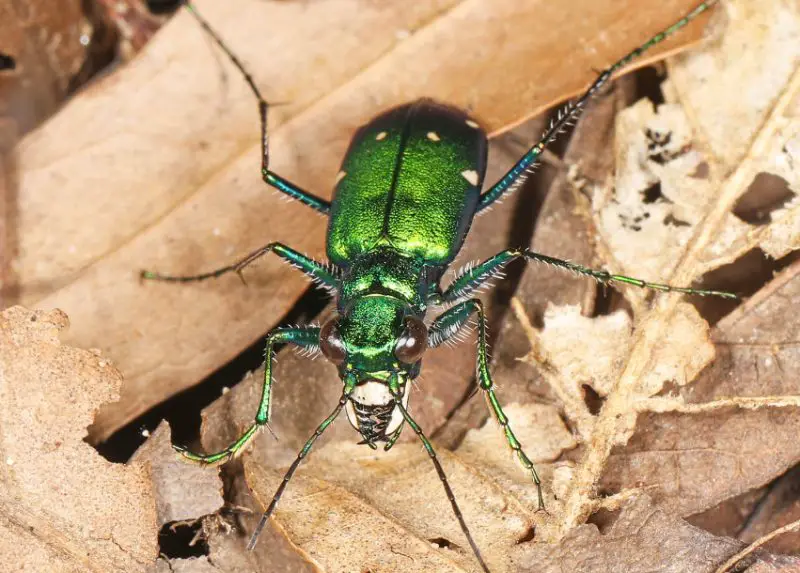
The Six-Spotted Tiger Beetle (Cicindela sexguttata) earns its name from the six distinct white spots on its elytra, though variations exist. Some specimens display green elytra with spots. Sporting a metallic green hue, it features overlapping mandibles, aiding in its forest identification. Found predominantly in woodlands, they prey on spiders and other arthropods, occasionally nipping humans when handled. These beetles frequent sandy woodland areas, serving as mating and nesting grounds for emerging nymphs.
Common Green June Beetle

The Common Green June Beetle (Cotinis nitida) is prevalent throughout North America, recognizable by its vivid green hue. While its mid-dorsal section is predominantly green, its sides exhibit a golden or brownish tint. The head shares the green coloration, contrasting with brown or golden legs. With age, the beetle may darken from its initial bright green shade. A pest to fruit trees like pear and apple, its green and golden camouflage aids in blending into the ecosystem.





